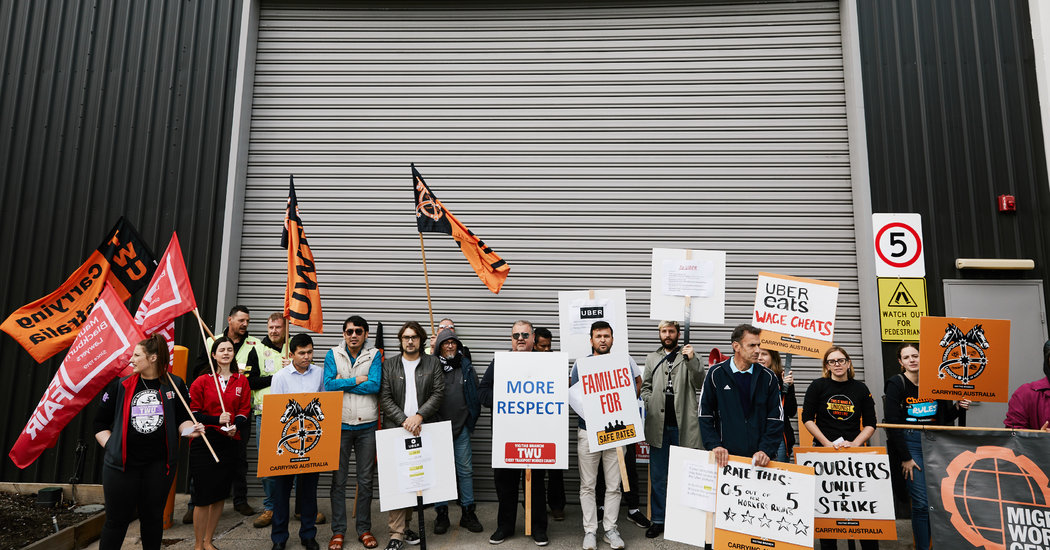A day of strikes planned by Uber drivers in cities around the world drew a modest turnout on Wednesday, as protesters denounced the ride-hailing giant’s employment and pay practices before its blockbuster initial public offering this week.
In Britain, some drivers, joined by members of other unions, protested at Uber offices around the country. About two dozen protesters outside the British headquarters in East London banged drums; released a smoke flare; displayed banners that read, “Uber sell off: Billions to bosses, poverty pay for drivers”; and chanted, “Uber, Uber, you can’t hide, we can see your greedy side.”
In San Francisco, hundreds of protesters blocked the street in front of Uber’s headquarters as a brass band played. They carried signs that said Uber and Lyft, its primary rival in the United States, which went public in March, were “launching I.P.O.s on the backs of their drivers.”
And outside Uber’s New York City headquarters in Queens, about 50 drivers and their supporters protested their wages and some of the employment practices of ride-hailing companies, chanting: “Driver power! Union power!” They said they felt they were being treated unfairly by companies that they had helped turn into transportation Goliaths.
“We invest in this company,” said Georges Colois, an Uber driver for more than two years in New York, pointing to the costs of renting or buying a car and paying for its upkeep and fuel, all to the benefit of the ride-hailing companies.
“I believe we deserve some respect and to be paid fairly,” he said.
The strikes were one of the biggest coordinated efforts by drivers to demonstrate their grievances against Uber and Lyft, organizers and drivers said. The protests garnered support from several candidates for the Democratic presidential nomination, including Senators Bernie Sanders of Vermont, Elizabeth Warren of Massachusetts and Kamala Harris of California.
But the strikes were largely muted. At La Guardia Airport in New York on Wednesday morning, cars driving for Uber and Lyft picked up passengers, and one airport worker said the flow of for-hire cars was typical for the time of day. Most drivers interviewed said they were either unaware of the strike or unable to participate because they needed to earn money.
At the heart of the drivers’ frustration is their status as independent contractors, not full-time workers. Ride-hailing companies argue that drivers prefer the flexible schedule of a freelancer. But drivers lack full-time benefits like health care and have said they have little control over their wages because the companies set the fares and take a cut of the fees they earn from rides.
In Melbourne, Australia, about 30 protesters gathered near an Uber facility, holding signs that said, “On-demand workers demand a living wage,” and chanting: “Uber, Uber, you must listen. We will break your algorithm!” Their complaints included falling pay, long hours and a lack of sick leave.
[Get the Bits newsletter for the latest from Silicon Valley and the technology industry.]
The strikes were timed right before Uber’s public offering, with the company set to start trading its shares on the stock market on Friday. Uber is the biggest of a generation of technology start-ups that base their businesses on smartphones and use so-called gig workers. The company is expected to be valued at more than $80 billion in its I.P.O., and its founders and investors are set to reap billions of dollars in wealth.
But that windfall will largely skip the drivers. Although Uber has said it intends to award cash bonuses to more than 1.1 million drivers — with those in the United States having the option to buy the company’s stock in the I.P.O. — drivers have called that a fig leaf. They said the wealth being gained by top executives and private investors had prompted the action on Wednesday.
Mostafa Maklad, a driver in San Francisco who worked with the group Gig Workers Rising to help organize the protest, said he had received an I.P.O. bonus of about $500 from Uber after driving for four years.
“They are just throwing us crumbs from how much money they will make,” he said.
Annette Rivero, who drives for Uber and Lyft in San Francisco, said she had recently struggled to keep up with her rent and bills as the ride-hailing companies cut back on incentive bonuses.
“I’m out until 4 a.m. trying to make money to pay my phone bill the next day,” she said.
In Chicago, a group of drivers called Chicago Rideshare Advocates has put forth a legislative wish list that includes pay-rate increases, a cap on the number of ride-hailing vehicles in the city and an independent way for drivers to appeal suspensions or banishment, known as deactivation.
Eli Solomon Martin, a founder of the group, said seemingly arbitrary deactivations were among the most frustrating aspects of work as a driver.
“If you haven’t had an unfair deactivation, you know someone who has,” Mr. Martin said.
More than three million people drive for Uber globally and have earned $78.2 billion from the service since 2015, the company said in a recent regulatory filing. In a statement on Tuesday, Uber said, “Drivers are at the heart of our service ─ we can’t succeed without them ─ and thousands of people come into work at Uber every day focused on how to make their experience better, on and off the road.”
Lyft said in a statement, also on Tuesday, that driver earnings had increased over the last two years.
“We know that access to flexible, extra income makes a big difference for millions of people, and we’re constantly working to improve how we can best serve our driver community,” a spokesman said.

